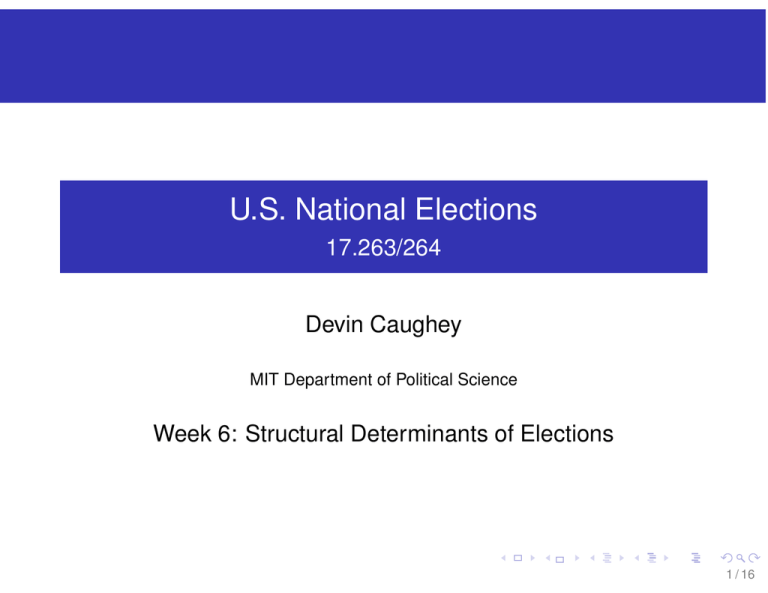
U.S. National Elections
17.263/264
Devin Caughey
MIT Department of Political Science
Week 6: Structural Determinants of Elections
1 / 16
Themes of the Day
Structural factors limit politicians’ influence over electoral
outcomes.
Predicting the past is hard, but predicting the future is even
harder.
Partisan balance in the electorate (normal vote)
Peace and prosperity benefit incumbents (retrospective
voting).
The president’s party is punished in midterms (balancing).
2 / 16
Presidential elections are highly predictable—
at least after the fact.
3 / 16
The Hibbs Model
Courtesy of Douglas Hibbs. Used with permission.
4 / 16
Two “objective” factors:
1
2
“Bread”: income growth in previous term
“Peace”: (absence of) fatalities from unprovoked wars
No survey results or other endogenous predictors.
5 / 16
Is Obama’s Fate Sealed?
Courtesy of Douglas Hibbs. Used with permission.
6 / 16
Maybe Not
Nate Silver’s Two-Party Vote Forecast (“Fivethirtyeight”)
© Nate Silver. All rights reserved. This content is excluded from our Creative
Commons license. For more information http://ocw.mit.edu/help/faq-fair-use/.
7 / 16
Silver’s forecast incorporates polls, previous election
results, ???
“Prediction” in a very different sense.
What do forecasts tell us, other than who will win?
8 / 16
Models of Vote Choice
“Position” versus “valence”
“Retrospective” versus “prospective”
“Pocketbook” versus “sociotropic”
Most election forecasts are based on a retrospective
sociotropic valence model: How well did the incumbent
party ensure peace and prosperity?
9 / 16
Partisanship and the Normal Vote
Balance of power between the parts sets the baseline
“normal vote”
10 / 16
Demographics versus Economics
The emerging Democratic majority?
Demographic changes vs. short-term economic factors
11 / 16
The Puzzle of Midterm Loss
Seemed like universal law until 1998 and 2002
Returned with a vengeance in 2006 and 2010.
Explanation 1: Surge-and-decline (coattails)
But incumbent party does even worse in midterms than
this would predict
Explanation 2: Ideological Balancing
13 / 16
Ideological Extremity
© source unknown. All rights reserved. This content is excluded from our Creative
Commons license. For more information, see http://ocw.mit.edu/help/faq-fair-use/.
14 / 16
Ideological Balancing
Balancing between partisan extremes
Separation of powers
15 / 16
Normative Implications
Can voters hold officeholders accountable, given how little
they know about politics?
Limitations?
16 / 16
MIT OpenCourseWare
http://ocw.mit.edu
17.263 / 17.264 U.S. National Elections
Fall 2014
For information about citing these materials or our Terms of Use, visit: http://ocw.mit.edu/terms.

